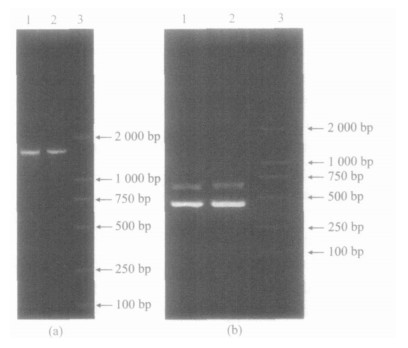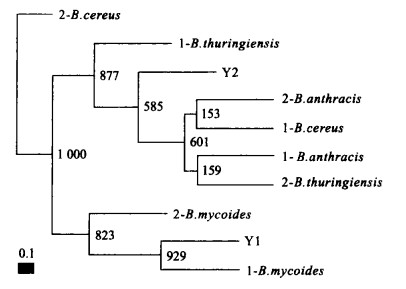Molecular Identification of Gold-Mineralization Indicating Bacteria
-
摘要: 近年来, 土壤微生物蜡样芽孢杆菌(Bacillus cereus)芽孢计数对下伏金矿化的指示作用已被不同国家的地质工作者所证实, 但由于鉴别手段的限制, 对金矿化指示菌株的鉴定一直停留在传统的微生物分类鉴定上, 本研究将分子生物学的技术引入到金矿化指示菌株的鉴定中, 从而将微生物找矿中的微生物鉴定手段提高到分子水平.从湖北省嘉鱼县蛇屋山金矿区分离到的矿化指示菌株中随机挑取2株菌Y1和Y2, PCR扩增并测定其16SrDNA和16S-23SrDNA区间序列.经系统发育和生理生化试验综合分析, 表明Y1为蕈状芽孢杆菌(B.mycoides), Y2为蜡样芽孢杆菌, 两者都属于蜡样芽孢杆菌群, 证明蜡样芽孢杆菌群是金矿化指示菌, 同时也证明了传统微生物找矿法利用选择性培养基对蜡样芽孢杆菌群菌芽孢计数方法的可靠性和利用分子生物学技术进行采矿的可行性.菌株16SrDNA和16S-23SrDNA区间核苷酸序列的确定也为下一步微生物找矿中的基因探针试剂盒的制作奠定了基础.
-
关键词:
- 16SrDNA /
- 16S-23SrDNA间区 /
- 菌种鉴定 /
- 金矿化指示菌 /
- 微生物找矿
Abstract: Recently the microbial mineral exploration method, spore counting of Bacillus cereus in soil samples which is indicative for blind gold ore deposit, has been confirmed by many geologists in different countries. However, the identification of bacterial strains, indicators for gold mineralization, was still done through the culturing method in previous studies. This paper employed molecular biology technique to microbial identification in mineralized areas. Two bacterial strains as indicators of gold mineralization were randomly isolated from the gold deposit of Shewu mountain in Jiayu county, Hubei Province. On the basis of biochemical and physiological identification, phylogenetic analysis dedrived from 16S rDNA and 16S-23S rDNA sequence, strains Y1 and Y2 were identified as Bacillus mycoides and B. cereus respectively, both of which belong to "B. cereus group". So it is "B. cereus group" that is the indicator for gold mineralization instead of B. ceresus species. The results assured the reliability of the traditional selective culturing method of B. cereus group, and the feasibility of molecular biology techniques on mineral exploration. In addition, 16S rDNA and 16S-23S rDNA sequence analyses were helpful to make fluorogenic-probe reagent box in future work. -
表 1 16SrDNA基因序列来源和数据库存取号
Table 1. 16SrDNA sources and accession number

表 2 ITS基因序列来源和数据库存取号
Table 2. ITS sources and accession number

表 3 供试菌株的几项生理生化特性
Table 3. Some physiological characteristics of strains Y1 and Y2

-
Ash, C., Farrow, J. A., Dorsch, M., et al., 1991. Compartive analysis of Bacillus anthracis, Bacillus cereus, and related species on the basis of reverse transcriptase sequencing of 16S rRNA. Int. J. Syst. Bacteriol., 41: 343 - 346. doi: 10.1099/00207713-41-3-343 Ash, C., Collins, M. D., 1992. Comparative analysis of 23S ribosomal RNA gene sequences of Bacillus anthracis and emetic Bacillus cereus determined by PCR-direct sequencing. FEMS Microbiol. Lett., 94: 75 - 80. doi: 10.1111/j.1574-6968.1992.tb05292.x Bjarne, M. H., Thomas, D.L., Niels, B. H., 2001. Polymerase chain reaction assay for the detection of Bacillus cereus group cells. FEMS Microbiol. Lett., 202: 209 -213. doi: 10.1111/j.1574-6968.2001.tb10805.x Daniele, D., Ameur, C., Sara, B., 2000. Homoduplex and heteroduplex polymorphis ms of the amplified ribosomal 16S-23Sinternal transcribed spacers describe genetic relationships in the "Bacillus cereus group". Applied and Environmental Microbiology, 66: 5460 - 5468. doi: 10.1128/AEM.66.12.5460-5468.2000 Devereux, R., He, S.H., Doyle, C.L., et al., 1990. Diversity and origin of Desulfovibrio species: Phylogenetic definition of a family. J. Bacteriol., 172: 3609 - 3619. doi: 10.1128/jb.172.7.3609-3619.1990 Drobniewski, F. A., 1993. Bacillus cereus and related species. Clin. Microbiol. Rev ., 6: 324 - 338. doi: 10.1128/CMR.6.4.324 Fry, N.K., Warwick, S., Saunders, N. A., et al., 1991. The use of 16S ribosomal RNA analyses to investigate the phylogeny of the family Legionellaceae. J. Gen. Microbiol., 137: 1215 - 1222. doi: 10.1099/00221287-137-5-1215 Jiao, Z.Q., Liu, X. M., 1998.16S rRNA sequence homology analysis and systematics and identification of bacteria. Foreign Medical Sciences ·Section of Hygienics, 25 (1): 12 - 16 (in Chinese). Jiao, Z.Q., Liu, X. M., 2001. The hot discussion about systematics and identification of bacteria: 16S-23S rDNA internal transcribed spacer. Microbiology, 28 (1): 85 - 89 (in Chinese). Li, Z.F., Li, X.J., Zhang, R.Z., et al., 1994. A microbial method of geochemical exploration—A study of using soil Bacillus cereus method to prospect for Au and U. Uranium Geology, 10 (6): 360 - 365 (in Chinese with English abstract). Melchior, A., Cardenas, J., Dejonghe, L., 1994. Geomicrobiology applied to mineral exploration in Mexico. J. Gechem. Explor., 51 (2): 193 - 212. doi: 10.1016/0375-6742(94)90017-5 Melchior, A., Ddjonghe, L., Hughes, G., 1996. A geomicrobiological study of soils collected from auriferous areas of Argentina. J. Geochem. Explor., 56: 217 - 227. Gurtler, V., Stanisich, V. A., 1996. New approaches to typing and identification of bacteria using the 16S-23S rDNA spacer region. Microbiology, 142: 3 - 16. doi: 10.1099/13500872-142-1-3 Wang, H. M., Yang, F. Q., Zhou, Q. W., et al., 1999. The gold depositʾs upper soil in the northwest of Sichuan Province. Earth Science—Journal of China University of Geosciences, 24 (Suppl. ): 78 - 82 (in Chinese with English abstract). Wang, H.M., Yang, F.Q., Zhou, X.G., et al., 2003a. Evaualtion of the potential of microbial exploration for gold ores: Mineralized and non-mineralized factors. Sciencein China (Series D), 46(5): 508 - 515. Wang, H. M., Yang, F. Q., Qiao, S. Y., 2003b. Characteristics of Bacillus cereus spore counts in soils with underlying gold mineralization in Northwestern Sichuan, China: Results from a pilot study. Journal of China University of Geosciences, 14(1): 8 - 15. Wang, Y., Tan, K.X., Liu, S.S., et al., 2003. Experimental study of gold adsorption by minerals and its signification in forming of lateritic gold deposits. Earth Science—Journal of China University of Geosciences, 28 (1): 26 - 30 (in Chinese with English abstract). Watterson, J.R., 1985. A procedure for estimating Bacillus cereus spores in soil and stream-sediment samples—A potential exploration technique. J. Geochem. Explor., 23: 243 - 252. doi: 10.1016/0375-6742(85)90028-7 Xie, S.C., Yin, H.F., Wang, H.M., et al., 1997. A potential microbial method of mineral exploration: Study on Bacillus cereus as anindicator of gold mineralization. Earth Science—Journal of China University of Geosciences, 22(4): 383 - 386 (in Chinese with English abstract). 焦振泉, 刘秀梅, 1998.16S rRNA序列同源性分析与细菌系统分类鉴定. 国外医学卫生学分册, 25 (1): 12 - 16. https://www.cnki.com.cn/Article/CJFDTOTAL-GWYX801.003.htm 焦振泉, 刘秀梅, 2001. 细菌分类与鉴定的新热点: 16S - 23S rDNA间区. 微生物学通报, 28 (1): 85 - 89. doi: 10.3969/j.issn.0253-2654.2001.01.022 李珍福, 李学军, 张瑞增, 等, 1994. 微生物地球化学探矿———蜡样芽孢杆菌法寻找铀矿的试验研究. 铀矿地质, 10 (6): 360 - 365. https://www.cnki.com.cn/Article/CJFDTOTAL-YKDZ406.005.htm 王红梅, 杨逢清, 周乔伟, 等, 1999. 川西北地区金矿床上覆土壤Bacillus cereus对金矿化的指示意义. 地球科学———中国地质大学学报, 24(增刊): 78 - 82. 王燕, 谭凯旋, 刘顺生, 等, 2003. 矿物吸附金的实验研究及其在红土型金矿形成中的意义. 地球科学———中国地质大学学报, 28 (1): 26 - 30. https://www.cnki.com.cn/Article/CJFDTOTAL-DQKX200301006.htm 谢树成, 殷鸿福, 王红梅, 等, 1997. 一种潜在的微生物找矿法———蜡样芽孢杆菌指示金矿化的试验研究. 地球科学———中国地质大学学报, 22(4): 383 - 386. https://www.cnki.com.cn/Article/CJFDTOTAL-DQKX704.011.htm -










 下载:
下载:



